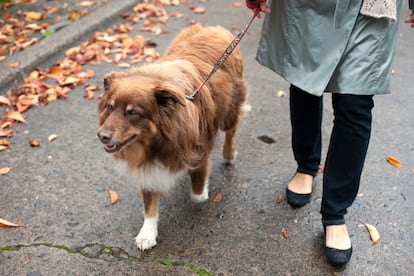Guidelines for enjoyably walking your dog on a leash: start using them when they’re puppies but not as an accessory for control
Nervousness and pulling on the harness are some of the difficulties that can arise when taking pets outside. According to experts, choosing the right leash and letting canines sniff around are two keys for avoiding these situations

Do you walk your dog, or does your dog walk you? Time spent outside with your pet should be a moment of enjoyment, but it can become stressful, due to tugging on the leash or possible confrontations with other dogs. Why do these complications occur when walking an animal on a leash? “Dogs usually go for a walk with a high level of arousal, because they want to relieve themselves, they want to get to the park to play or because they are nervous about the street,” explains Helena Bat, a psychologist specializing in animal behavior and animal welfare. During these times, the animal needs a specific rhythm when walking, and a gap is created between what the dog needs and what its owner does. “It requires fast movements, and when they are tied up, they can’t do it, because we humans don’t have that rhythm when we leave the house, and sometimes we even ask them to stop, wait or sit,” she adds.
People who live with dogs are often concerned that walks with their animals can become a stressful time. “A high percentage of consultations are usually related to this issue, and the situation can worsen when the animal hardly leaves the house to avoid conflicts during the walk and they choose to do their business in places like the garden,” says Rosario Galtier, a veterinarian and animal behavioralist; she is also the technical director of Ebavet, a veterinary center in Tenerife, Spain, dedicated exclusively to clinical ethology (animal behavior) and animal welfare. Galtier explains why dogs tug on the leash: reasons may include “never having taught the dog to use this walking accessory, or having chosen the wrong type, such as short leashes, which facilitate more tugging, or punishment collars, like those with electric shocks or spikes, which are not recommended.”
The most common situations that make it difficult for dogs to go out for walks include pulling on the leash, aggression toward other dogs or fear of other people and street stimuli like noises, Galtier notes. Animal behavioralist Helena Bat points out that animals tend to relax when they arrive at the park because they consider it a safe area for leisure: “When dogs are nervous, they tend to pull more on the leash, because they feel insecure and perceive threats. Therefore, the key to a good walk is for dogs to go out calmly and engage in the activities typical of their species, such as interacting with other dogs,” Bat emphasizes.
A dog’s acceptance of the leash
Walking on a leash does not come naturally to dogs, and they need to undergo a process of learning and accepting this walking accessory. “Dogs want to run, to explore everything, and it is normal that they tend to get frustrated when they see that there is a foreign object that prevents them from doing what they want to do. Therefore, we must teach them to walk on a leash and learn to go at our pace,” says Galtier. She adds that it is important to understand that the leash is for safety, so that the dog does not get lost or cause an accident, but it is not to be used as an accessory for control. “It should not be used to direct walks. If we don’t like them pulling on the leash, they don’t like us doing it either, and we can hurt their necks.”

When there is a behavioral problem — in this case, on walks with the leash — it is advisable to consult a professional. “The veterinarian will first rule out health problems and recommend a specialist in animal behavior who will help owners work with the dog to resolve the situation,” adds Galtier. For her part, animal behavioralist Helena Bat recommends encouraging dogs to sniff during their walks. “When they follow tracks, they are focused and tend to walk slowly. Many people don’t like that, and that’s when a dog jerks, but it’s important to allow them time to sniff, even if they walk slowly.”
A dog’s adaptation to the leash from the time he/she is a puppy is essential for pleasant, stress-free walks. “The first thing to do is start at home to work on the dog becoming accustomed to the placement of the harness and leash, as well as learning to walk on it,” Galtier advises. She also emphasizes the importance of socializing animals well to avoid fears, such as people or noises. “It is advisable for the puppy to leave the house, even if you’re holding him or her, to get used to situations such as traffic or the presence of other dogs.”
For dogs, a walk is much more than just doing their business
For dogs, going outside is a fundamental time to socialize with other dogs. It’s not just about them doing their business and coming home. “It’s when they get all kinds of cognitive and sensory stimulation. For example, when they smell another dog’s pee, their brain processes a lot of data, like they may know that other dog, they may have a certain relationship with that dog, or they may want to get to know more about it by sniffing,” animal behavioralist Helena Bat explains.
In addition, dogs get their exercise when going for a walk, which is good for their health. “An intense walk in which they run a lot is not necessary for their body to reap the benefits; going for a walk three times a day for 15 minutes can even help an older dog stay in shape,” Bat says.
Sign up for our weekly newsletter to get more English-language news coverage from EL PAÍS USA Edition
Tu suscripción se está usando en otro dispositivo
¿Quieres añadir otro usuario a tu suscripción?
Si continúas leyendo en este dispositivo, no se podrá leer en el otro.
FlechaTu suscripción se está usando en otro dispositivo y solo puedes acceder a EL PAÍS desde un dispositivo a la vez.
Si quieres compartir tu cuenta, cambia tu suscripción a la modalidad Premium, así podrás añadir otro usuario. Cada uno accederá con su propia cuenta de email, lo que os permitirá personalizar vuestra experiencia en EL PAÍS.
¿Tienes una suscripción de empresa? Accede aquí para contratar más cuentas.
En el caso de no saber quién está usando tu cuenta, te recomendamos cambiar tu contraseña aquí.
Si decides continuar compartiendo tu cuenta, este mensaje se mostrará en tu dispositivo y en el de la otra persona que está usando tu cuenta de forma indefinida, afectando a tu experiencia de lectura. Puedes consultar aquí los términos y condiciones de la suscripción digital.
More information
Últimas noticias
Not all insomnia is the same: Study identifies five subtypes and paves the way for personalized treatment
The United States designates Clan del Golfo as a foreign terrorist group
The United States strikes three more suspected drug boats, killing eight
The Iberian Peninsula is rotating clockwise, scientists report
Most viewed
- ‘El Limones’ and the growing union disguise of Mexican organized crime
- Christian Louboutin: ‘Young people don’t want to be like their parents. And if their parents wear sneakers, they’re going to look for something else’
- ‘We are dying’: Cuba sinks into a health crisis amid medicine shortages and misdiagnosis
- A mountaineer, accused of manslaughter for the death of his partner during a climb: He silenced his phone and refused a helicopter rescue
- The low-cost creative revolution: How technology is making art accessible to everyone











































